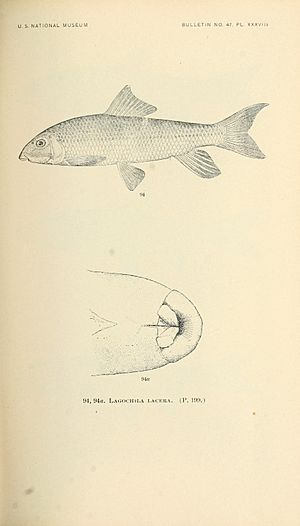Harelip sucker facts for kids
Quick facts for kids Harelip sucker |
|
|---|---|
 |
|
| Conservation status | |
| Scientific classification | |
| Synonyms | |
|
The harelip sucker (Moxostoma lacerum) was a type of ray-finned fish that lived in the United States. It belonged to the family called Catostomidae, which includes many kinds of suckers. Sadly, this fish is now extinct, meaning it has completely disappeared from Earth. No one has seen a live harelip sucker since 1893.
Contents
What the Harelip Sucker Looked Like
The harelip sucker had a very unique mouth. Its upper lip could not extend forward, and its lower lip was split into two clear parts. These features made it different from all other suckers.
Its head was quite short, making up about 20 to 22 percent of its body length. The fin on its back, called the dorsal fin, had 11 or 12 soft rays. The edge of this fin was slightly curved inward.
The fish had a complete lateral line, which is a sensory organ that runs along its side. This line contained 42 to 46 scales. Scientists David Starr Jordan and Alembert Winthrop Brayton described its colors. Its back was olive to brownish. Its belly and sides were shiny silver or white.
The fins on its underside were a bit orange. The other fins were creamy or dark. The dorsal fin was dark and had a black edge. Even though it looked different, its colors were similar to the blacktail redhorse fish.
Where the Harelip Sucker Lived
Scientists first collected a harelip sucker in 1859. They officially described it in 1877. This fish was found across a wide area in the United States. It lived from the southeastern states up to the Ohio River basin. It was also found in the White River area of the Ozarks. You could also find it in the Maumee system near Lake Erie.
The harelip sucker holds a sad record. It is the fish species that disappeared from the most American states, a total of eight. The very last specimen was collected in 1893. By 1970, scientists believed the species was completely extinct.
In Alabama, the only known harelip sucker was found in Cypress Creek in 1889. In the 1990s, the Alabama Department of Conservation tried to find them again. They searched Cypress Creek many times but did not find any. They looked at 30 different fish species, including six types of suckers, but no harelip suckers.
The last researcher to report finding a specimen said he got it from the Elk River in 1882. This was probably in Tennessee. Scientists think these fish died out because their homes changed. This change was mainly due to something called siltation.
Harelip Sucker Habitat and Diet
Harelip sucker populations lived in clear streams. These streams usually had bottoms made of gravel or rock. The water currents were moderate to fast.
The unusual shape of the harelip sucker's lips suggests it had a very specific diet. Scientists studied the stomachs of preserved specimens. They found that these fish ate snails, limpets, fingernail clams, and other small crustaceans.
These fish used their eyesight to find food. They needed very clear streams to see their prey.
Life Cycle of the Harelip Sucker
Because the harelip sucker became extinct so early, we don't have many detailed studies about its life. However, we do have some information from about 30 preserved fish.
We know very little about its exact habitat or how it lived day-to-day. But Klippart (1878) wrote that people called them "May suckers." This was because they spawned, or laid their eggs, in May.
The only other thing we know is that adult harelip suckers could grow quite large. They reached about 18 inches (45 cm) in length. They also weighed several pounds. Even with its wide range, this fish was the first to become recently extinct. The last one was found in 1893.
Why the Harelip Sucker Became Extinct
Scientists believe that human activities caused the harelip sucker to die out. In the 1800s and early 1900s, there were no rules about cutting down forests or farming land. This led to a lot of soil washing into the rivers.
This process is called siltation. It made the harelip sucker's habitat very muddy. This was a big problem for the fish because they fed by sight. The muddy water made it impossible for them to see their food.
The siltation also killed the mollusks and crustaceans that the harelip suckers ate. These small creatures were their main food source. So, the harelip suckers essentially starved to death. Their decline likely started with the clearing of forests and farming in the early 1800s.
See also
 In Spanish: Moxostoma lacerum para niños
In Spanish: Moxostoma lacerum para niños


